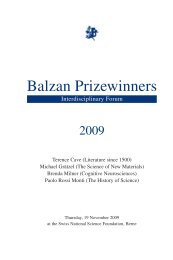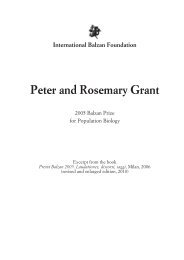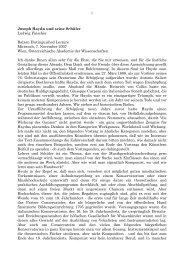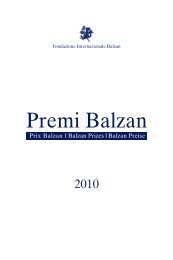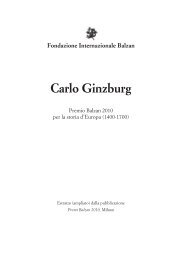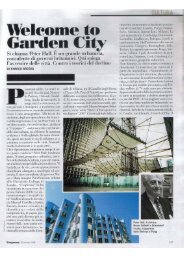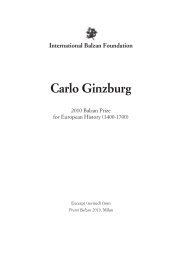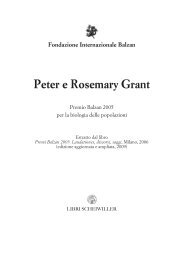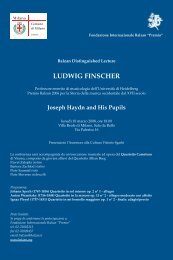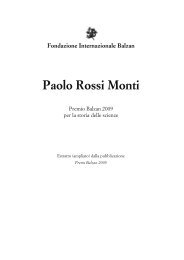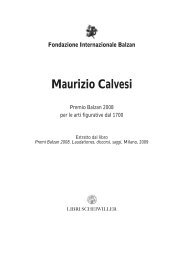Russell J. Hemley and Ho-kwang Mao
Russell J. Hemley and Ho-kwang Mao
Russell J. Hemley and Ho-kwang Mao
You also want an ePaper? Increase the reach of your titles
YUMPU automatically turns print PDFs into web optimized ePapers that Google loves.
2005 Balzan Prize<br />
deed, one of the primary aims of modern mineral physics has been to supply the<br />
missing link between the global <strong>and</strong> the atomic – how planetary structure, dynamics,<br />
<strong>and</strong> evolution are controlled by the fundamental physical <strong>and</strong> chemical<br />
properties of the component materials, <strong>and</strong> not just for the Earth but also for all<br />
bodies in the solar system <strong>and</strong> beyond. The field of mineral physics not only supplies<br />
that link, it has also established entirely new avenues of research. An array<br />
of transformations in solids, liquids, <strong>and</strong> gases under the extreme pressure-temperature<br />
conditions of deep planetary interiors have been discovered, thus identifying<br />
the “brave, new world” of materials within planets, which is utterly different<br />
from that observed at or near planetary surfaces. Detailed in situ measurements<br />
of the physical <strong>and</strong> chemical properties of a broad range of relevant materials<br />
have been carried out up to the pressures found at the center of the Earth<br />
(3.6 Mbar). These measurements have revealed new bonding, electronic, magnetic<br />
<strong>and</strong> structural states in materials, requiring the extension of established precepts<br />
developed in the early years of quantum mechanics by Linus Pauling 7 <strong>and</strong><br />
Eugene Wigner <strong>and</strong> Frederick Seitz. 8 Due to pressure-induced changes in chemical<br />
affinities, the reactivities of otherwise familiar elements <strong>and</strong> compounds are<br />
totally altered, <strong>and</strong> entirely new classes of materials appear. For organic materials,<br />
these changes occur at very modest pressures, with results that have major implications<br />
for life in extreme environments elsewhere in the solar system. At combined<br />
high pressures <strong>and</strong> temperatures, novel electronic <strong>and</strong> structural properties<br />
emerge, creating new phases that can be recovered to ambient conditions. Indeed,<br />
underst<strong>and</strong>ing the broad spectrum of phenomena exhibited in simple molecular<br />
systems up to multimegabar pressures <strong>and</strong> from the millikelvin range to<br />
the highest temperatures goes to the core of our underst<strong>and</strong>ing of materials. 9<br />
Professional Background<br />
In 1964, <strong>Mao</strong> started his Ph.D. thesis work at the University of Rochester, using<br />
the diamond-anvil cell for studies of mantle minerals under the guidance of<br />
William A. Bassett <strong>and</strong> Taro Takahashi. In 1968, he joined the Geophysical Laboratory,<br />
a world-leading high-pressure center, for post-doctoral work on crystalfield<br />
spectroscopy of lunar <strong>and</strong> terrestrial minerals with Peter M. Bell, himself a<br />
student of Francis Birch <strong>and</strong> Percy W. Bridgman, recipient of the 1946 Nobel<br />
Prize in Physics for his contribution to high-pressure research. At Carnegie, <strong>Mao</strong><br />
broadened his expertise <strong>and</strong> began to utilize other high-pressure devices such as<br />
the hydrothermal bomb, Birch gas apparatus, Bridgman squeezer, piston-cylin-<br />
10



